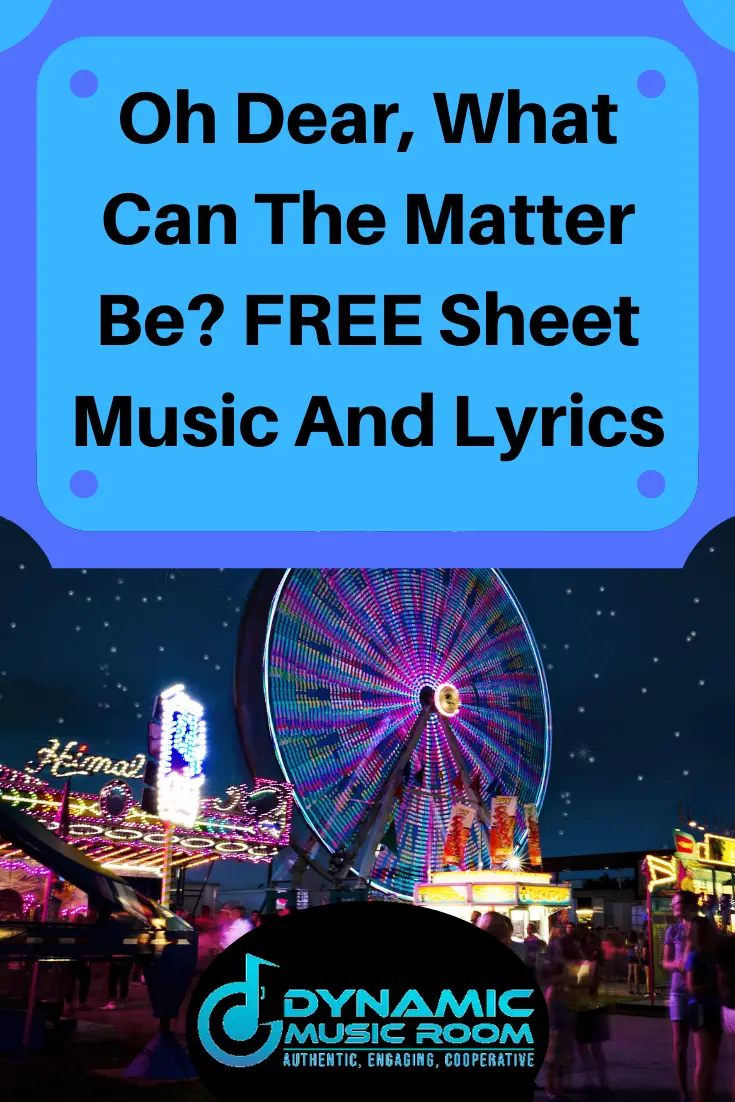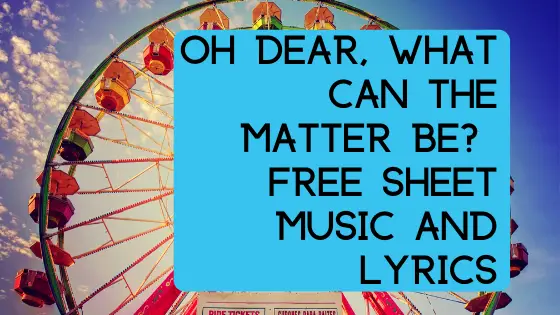Are you looking for a fun song in triple meter or 6/8 time?
Do you want to reinforce the division of the beat in groups of three?
Not every song is going to be one we get excited for; some of them just get stuck in your head forever!
This song is one of them. It must be a quality song because it hangs around in your head.
For those who want to teach it or learn it, here is Oh Dear, What Can The Matter Be? sheet music.
Look ahead at the rest of the article for the FREE sheet music, lyrics, and a sample music lesson.
Table of Contents
Oh Dear, What Can The Matter Be? Sheet Music
Rhythm: 6/8 meter: single eighth pickup (with eighth notes rest before), dotted half note, 3 eighth notes, dotted quarter note
Pitches: do, re, mi, fa, sol, do’
History: This song is known as far back as 1770s England.
It’s also known as “Johnny’s So Long At The Fair.” This name is drawn from the ending line of the phrase.
The Oxford Dictionary of Nursery Rhymes by the Opies trace this back to a folk ballad with different lyrics but the same pattern of phrasing.
Though the song started in England, it achieved great success and popularity in post-independence America when the song as a duet was featured at Samuel Harrison concerts.
As with most folk songs, there are parody versions which have arisen throughout the years. These range from simply comedic to outright inappropriate.
You may also enjoy learning Peas, Porridge, Hot.
Oh Dear, What Can The Matter Be? Lyrics
The traditional lyrics are as follows:
1. Oh dear, what can the matter be?
Oh dear, what can the matter be?
Oh dear, what can the matter be?
Johnny’s so long at the fair.
2. He promised he’d buy me a fairing should please me,
And then for a kiss oh he vowed he would tease me,
He promised he’d bring me a bunch of blue ribbons,
To tie up my bonny brown hair.
The earliest version of the lyrics were slightly different:
1. Oh, what can the matter be?
Oh, what can the matter be?
Oh, what can the matter be?
Johnny bydes long at the fair
2. He’ll buy me a twopenny whistle
He’ll buy me a threepenny fair
He’ll buy me a bunch of blue ribbons
To tie up my bonny brown hair
3. Oh, saw ye him coming
Oh, saw ye him coming
Oh, saw ye him coming
Him from the Newcastle fair
Source: Oxford Dictionary of Nursery Rhymes
The lyrics of the second verse are also simplified in some books to the following:
He promised he’d bring me a bunch of blue ribbons.
He promised he’d bring me a bunch of blue ribbons.
He promised he’d bring me a bunch of blue ribbons.
To tie up my bonny brown hair.

Sample Music Lesson Activity
This is a sample music lesson and activity I may do with my second or third-graders when doing this song. The activity is made up by me and reinforces the ideas of 6/8 meter.
What you’ll need: Drums of some kind. I like the Remo hand drums.
Set up: Students can do this in small groups of three or on their own depending on your space and available instruments.
Procedure:
#1 Teach The Song
Start by teaching the song if the students don’t know it already. This song is long enough it’s fine to teach it with a rote song procedure.
Here’s the basic of rote song procedure:
- Have students listen to the whole song 3-5 times.
- Students echo phrase 1.
- Students echo phrase 2.
- Echo phrases 1 and 2.
- Students echo phrase 3.
- Students echo phrase 3 and 4.
- Echo phrases 3 and 4 together.
- Echo phrases 1-4 together.
- Students sing whole together*.
*If there are more phrases in a song, expand the process as needed.
#2 Model → Small Group
After the song is learned, which may be done on a different day, it’s time to learn the activity. Since, we’re focusing on this activity on the 6/8 feel (or 3 divisions to the beat), this will be a movement and playing activity.
Kinesthetic – Ask the class to follow you in stepping from the left to right foot matching the macrobeat (big beat) of the song.
Now, ask them to throw in 2 claps on the microbeats between each big beat.
Here’s another way to think of it:
1 2 3 4 5 6 = Step clap clap step clap clap
Offer feedback and discuss how this aligns with the music. You’ve probably talked about divisions of the beat or at least duple vs triple, so this would be a good time to connect this discussion.
If you wish, it would be good to introduce the idea of 6/8 time with this.
Split the class into small groups and challenge them to help each other learn the triple patterns you give them.
- Pat head head
- Jump pat pat
- Etc
As always, circulate to offer specific feedback and manage behavior.
Visual – Write all the ideas on the board and ask the groups to discuss how the first and fourth beats were different than the others.
Have the small groups brainstorm ways to show this with pictures or shapes (for example: Down Up Up or Circle dot dot).
Linguistic – Have students say and move the words and moves you’ve been doing.
#3 Create In Groups Or Own Their Own
In small groups or on their own, have students create their own pattern to move and show while playing the song.
Circulate and assess.
#4 Add Instruments
Once a group has mastered it, offer the small group of 3 or individuals a hand drum or other instrument.
Ask the groups to come up with a way to play the drum or other instrument to show the strong-weak-weak pattern.
I prefer not to give examples and see what they come up with. If I give an example, the students seem stuck on the idea.
Doggy, Doggy, Where’s Your Bone? Is fun to play too.
Final Thoughts
I hope you like this enough to add it to your teaching or playing list and find the Oh Dear, What Can The Matter Be? sheet music useful to you.
With its lilting 6/8 meter and catchy melody, this one will be stuck in your head, and you probably won’t even care.
Check out more folk songs in 6/8 time.

